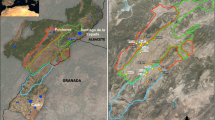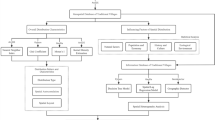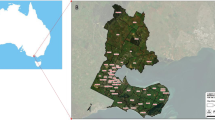Abstract
The simulation of rural land use systems in general, and rural settlement dynamics in particular, has developed with synergies of theory and methods for decades. Three current issues are: linking spatial patterns and processes, representing hierarchical relations across scales, and considering nonlinearity to address complex non-stationary settlement dynamics. We present a hierarchical simulation model to investigate complex rural settlement dynamics in Nang Rong, Thailand. This simulation uses sub-models to allocate new villages at three spatial scales. Regional and sub-regional models, which involve a nonlinear space–time autoregressive model implemented in a neural network approach, determine the number of new villages to be established. A dynamic village niche model, establishing a pattern–process link, was designed to enable the allocation of villages into specific locations. Spatiotemporal variability in model performance indicates that the pattern of village location changes as a settlement frontier advances from rice-growing lowlands to higher elevations. Simulation experiments demonstrate that this simulation model can enhance our understanding of settlement development in Nang Rong and thus gain insight into complex land use systems in this area.









Similar content being viewed by others
References
Agarwal C, Green GM, Grove JM, Evans TP, Schweik CM (2002) A review and assessment of land use change models: dynamics of space, time, and human choice. Gen Tech Rep NE-297. Newton Square, PA: U.S. Department of Agriculture, Forest Service, Northeastern Research Station. Available online at: http://www.treesearch.fs.fed.us/pubs/5027. Accessed 20 Jan 2009
Alberti M, Marzluff JM, Shulenberger E, Bradley G, Ryan C, Zumbrunnen C (2003) Integrating humans into ecology: opportunities and challenges for studying urban ecosystems. Bioscience 53(12):1169–1179. doi:10.1641/0006-3568(2003)053[1169:IHIEOA]2.0.CO;2
Austin MP (1985) Continuum concept, ordination methods, and niche theory. Annu Rev Ecol Syst 16:39–61. doi:10.1146/annurev.es.16.110185.000351
Batty M, Xie Y (1994) From cells to cities. Environ Plann B Plann Des 21:s31–s48. doi:10.1068/b21s031
Bell TL, Church RL (1985) Location-allocation modeling in archaeological settlement pattern research: some preliminary applications. World Archaeol 16(3):354–371
Bennett DA, Tang W (2006) Modelling adaptive, spatially aware, and mobile agents: elk migration in Yellowstone. Int J Geogr Inf Sci 20(9):1039–1066. doi:10.1080/13658810600830806
Bishop C (1995) Neural networks for pattern recognition. Oxford University Press, Oxford
Brown DG, Page S, Riolo R, Zellner M, Rand W (2005) Path dependence and the validation of agent-based spatial models of land use. Int J Geogr Inf Sci 19:153–174. doi:10.1080/13658810410001713399
Bura S, Guerin-Pace F, Mathian H, Pumain D, Sanders L (1996) Multiagent systems and the dynamics of settlement systems. Geogr Anal 28(2):161–178
Chatfield C (2004) The analysis of time series: an introduction, 6th edn. Chapman and Hall, Boca Raton
Christaller W (1966) Central places in Southern Germany. Prentice-Hall, Englewood Cliffs
Clarke KC, Hoppen S, Gaydos L (1997) A self-modifying cellular automaton model of historical urbanization in the San Francisco Bay area. Environ Plann B Plann Des 24:247–261. doi:10.1068/b240247
Cliff AD, Ord JK, Haggett P, Versey GR (1981) Spatial diffusion: an historical geography of epidemics in an island community. Cambridge University Press, New York
Cohen J (1960) A coefficient of agreement for nominal scales. Educ Psychol Meas 20:37–46. doi:10.1177/001316446002000104
Congalton RG (1991) A review of assessing the accuracy of classifications of remotely sensed data. Remote Sens Environ 37:35–46. doi:10.1016/0034-4257(91)90048-B
Congalton RG, Green K (1999) Assessing the accuracy of remotely sensed data: principles and practices. CRC/Lewis Press, Boca Raton
Dale MRT (1999) Spatial pattern analysis in plant ecology. Cambridge University Press, Cambridge
Dean JS, Gumerman GJ, Epstein JM, Axtell RL, Swedlund AC, Parker MT, McCarroll S (2000) Understanding Anasazi culture change through agent-based modeling. In: Kohler TA, Gumerman GJ (eds) Dynamics in human and primate societies: agent-based modeling of social and spatial processes. Oxford University Press, Oxford, New York, pp 179–205
Diggle PJ (2003) Statistical analysis of spatial point patterns. Oxford University Press, Oxford, New York
Diggle PJ, Cox TF (1983) Some distance-based tests of independence for sparsely-sampled multivariate spatial point patterns. Int Stat Rev 51:11–23. doi:10.2307/1402729
Entwisle B, Walsh SJ, Rindfuss RR, Chamratrithirong A, Liverman D, Morgan EF, Rindfuss RR, Stern PC (1998) Land-use/land-cover (LULC) and population dynamics, Nang Rong, Thailand. In: Liverman D, Moran EF, Rindfuss RR, Stern PC (eds) People and pixels: using remotely sensed data in social science research. National Academy Press, Washington, DC, pp 121–144
Entwisle B, Malanson GP, Rindfuss RR, Walsh SJ (2008) An agent based model of household dynamics and land use change: getting inside the black box. J Land Use Sci 3:73–93. doi:10.1080/17474230802048193
Faraway J, Chatfield C (1998) Time series forecasting with neural networks: a comparative study using the airline data. J R Stat Soc C Appl Stat 47:231–250. doi:10.1111/1467-9876.00109
Fotheringham AS, O’Kelly ME (1989) Spatial interaction models: formulations and applications. Kluwer, London
French MN, Krajewski WF, Cuykendall RR (1992) Rainfall forecasting in space and time using a neural network. J Hydrol (Amsterdam) 137:1–31. doi:10.1016/0022-1694(92)90046-X
Gahegan M (2003) Is inductive machine learning just another wild goose (or might it lay the golden egg)? Int J Geogr Inf Sci 17:69–92. doi:10.1080/713811742
Garner BJ (1967) Models of urban geography and settlement location. In: Chorley R, Haggett P (eds) Models in geography. Methuen, London, pp 303–360
Getis A (1964) Temporal land-use pattern analysis with the use of nearest neighbor and quadrat methods. Ann Assoc Am Geogr 54:391–399. doi:10.1111/j.1467-8306.1964.tb00497.x
Gould PG (1994) Neural computing and the aids pandemic: the case of Ohio. In: Hewitson BC, Crane RG (eds) Neural nets: applications in geography. Kluwer, Dordrecht, pp 101–120
Greig-Smith P (1983) Quantitative plant ecology. University of California, Berkeley
Haining R (1982) Describing and modeling rural settlement maps. Ann Assoc Am Geogr 72:211–223. doi:10.1111/j.1467-8306.1982.tb01820.x
Hecht-Nielsen R (1987) Kolmogorov’s mapping neural network existence theorem. In: Proceedings of IEEE first international conference on neural networks, San Diego, June 1987, III. IEEE, New York, pp 11–14
Hudson JC (1967) Theoretical settlement geography. Dissertation/Thesis, Unpublished, Department of Geography, The University of Iowa, Iowa City
Hudson JC (1969) A location theory for rural settlement. Ann Assoc Am Geogr 59:365–381. doi:10.1111/j.1467-8306.1969.tb00676.x
Huigen MGA (2004) First principles of the MameLuke multi-actor modelling framework for land use change, illustrated with a Philippine case study. J Environ Manag 72:5–21. doi:10.1016/j.jenvman.2004.01.010
Hutchinson GE (1958) Concluding remarks. Cold Spring Harb Symp Quant Biol 22:415–427
Kamarianakis Y, Prastacos P (2005) Space–time modeling of traffic flow. Comput Geosci 31:119–133. doi:10.1016/j.cageo.2004.05.012
Kendall MG (1970) Rank correlation methods. Griffin, London
Kohler TA, Carr E (1997) Swarm-based modeling of prehistoric settlement systems in south-western North America. In: Archaeological applications of GIS: Proceedings of Colloquium II, UISPP, 13th Congress, Forli, September 1996. Sydney University Archaeological Methods Series 5, Sydney University, Sydney (CD-ROM)
Koukoulas S, Blackburn GA (2001) Introducing new indices for accuracy evaluation of classified images representing semi-natural woodland environments. Photogramm Eng Remote Sens 67(4):499–510
Laland KN, Brown GR (2006) Niche construction, human behavior, and the adaptive-lag hypothesis. Evol Anthropol 15:95–104. doi:10.1002/evan.20093
Laland KN, Odling-Smee J, Feldman MW (2000) Niche construction, biological evolution, and cultural change. Behav Brain Sci 23:131–175. doi:10.1017/S0140525X00002417
Lapedes A, Farber R (1988) How neural nets work. In: Anderson DZ (ed) Neural information processing systems. American Institute of Physics, New York, pp 442–456
Levin SA (1998) Ecosystems and the biosphere as complex adaptive systems. Ecosystems (New York, Print) 1:431–436. doi:10.1007/s100219900037
Li X, Yeh AGO (2002) Neural network-based cellular automata for simulating multiple land use changes using GIS. Int J Geogr Inf Sci 16(4):323–343. doi:10.1080/13658810210137004
Macy MW, Willer R (2002) From factors to actors: computational sociology and agent-based modeling. Annu Rev Sociol 28:143–166. doi:10.1146/annurev.soc.28.110601.141117
Malanson GP (1999) Considering complexity. Ann Assoc Am Geogr 89:746–753. doi:10.1111/0004-5608.00174
Malanson GP, Zeng Y, Walsh SJ (2006) Complexity at advancing ecotones and frontiers. Environ Plan A 38:619–632. doi:10.1068/a37340
Manson S, O’Sullivan D (2006) Complexity theory in the study of space and place. Environ Plan A 38:677–692. doi:10.1068/a37100
Mitchell TM (1997) Machine learning. The McGraw-Hill companies, Inc., New York
Odling-Smee FJ, Laland KN, Feldman MW (2003) Niche construction: the neglected process in evolution. Princeton University Press, Princeton
Openshaw S, Openshaw C (1997) Artificial intelligence in geography. Wiley, New York
Pace RK, Barry R, Clapp JM, Rodriquez M (1998) Spatiotemporal autoregressive models of neighborhood effects. J Real Estate Finance Econ 17:15–33. doi:10.1023/A:1007799028599
Page M, Parisel C, Pumain D, Sanders L (2001) Knowledge-based simulation of settlement systems. Comput Environ Urban Syst 25:167–193. doi:10.1016/S0198-9715(00)00022-3
Parker DC, Manson SM, Janssen MA, Hoffmann MJ, Deadman, P (2002) Multi-agent systems for the simulation of landuse and land-cover change: a review. Ann Assoc Am Geogr 93(2):316–340
Pfeifer PE, Deutsch SJ (1980) Stationarity and invertibility regions for low order STARMA models. Commun Stat Simul Comput 9:551–562. doi:10.1080/03610918008812173
Pijanowski BC, Pithadia S, Shellito BA, Alexandridis K (2005) Calibrating a neural network-based urban change model for two metropolitan areas of the Upper Midwest of the United States. Int J Geogr Inf Sci 19(2):197–215. doi:10.1080/13658810410001713416
Pontius RG (2002) Statistical methods to partition effects of quantity and location during comparison of categorical maps at multiple resolutions. Photogramm Eng Remote Sens 68:1041–1049
Popkov YS, Shvetsov VI, Weidlich W (1998) Settlement formation models with entropy operator. Ann Reg Sci 32:267–294. doi:10.1007/s001680050074
Pumain D (2000) Settlement systems in the evolution. Geogr Ann Ser B 82(2):73–87. doi:10.1111/j.0435-3684.2000.00075.x
Pumain D (2007) The socio-spatial dynamics of systems of cities and innovation processes: a multi-level model. In: Albeverio S, Andrey D, Giordano P, Vancheri A (eds) The dynamics of complex urban systems. Physica-Verlag, Heidelberg, pp 373–389
Ripley BD (1977) Modelling spatial patterns (with discussion). J R Stat Soc B 39:172–212
Rumelhart DE, Hinton GE, Williams RJ (1986) Learning representations by back-propagating errors. Nature 323:533–536. doi:10.1038/323533a0
Russell SJ, Norvig P (1995) Artificial intelligence: a modern approach. Prentice Hall, New Jersey
Sanders L (2006) Cognition and decision in multi-agent modeling of spatial entities at different geographical scales. In: Portugali J (ed) Complex artificial environments: simulation, cognition and VR in the study and planning of cities. Springer, Berlin, pp 201–218
Sanders L, Pumain D, Mathian H, GuerinPace F, Bura S (1997) SIMPOP: a multiagent system for the study of urbanism. Environ Plann B Plann Des 24:287–305. doi:10.1068/b240287
Schmit C, Rounsevell MDA (2006) Are agricultural land use patterns influenced by farmer imitation? Agric Ecosyst Environ 115:113–127. doi:10.1016/j.agee.2005.12.019
Semple RK, Golledge RG (1970) An analysis of entropy changes in a settlement pattern over time. Econ Geogr 46(2):157–160. doi:10.2307/142623
Tang W (2008) Simulating complex adaptive geographic systems: a geographically aware intelligent agent approach. Cartogr Geogr Inform 35(4):239-263
Tibshirani R (1996) A comparison of some error estimates for neural network models. Neural Comput 8:152–163. doi:10.1162/neco.1996.8.1.152
Upton GJG (1986) Distance and directional analyses of settlement patterns. Econ Geogr 62(2):167–179. doi:10.2307/144090
Vandermeer JH (1972) Niche theory. Annu Rev Ecol Syst 3:107–132. doi:10.1146/annurev.es.03.110172.000543
Veldkamp A, Fresco LO (1996) CLUE-CR: an integrated multi-scale model to simulate land use change scenarios in Costa Rica. Ecol Model 91:231–248. doi:10.1016/0304-3800(95)00158-1
Veldkamp A, Fresco LO (1997) Reconstructing land use drivers and their spatial scale dependence for Costa Rica (1973 and 1984). Agric Syst 55:19–43. doi:10.1016/S0308-521X(95)00080-O
Veldkamp A, Verburg PH, Kok K, de Koning GHJ, Priess J, Bergsma AR (2001) The need for scale sensitive approaches in spatially explicit land use change modeling. Environ Model Assess 6:111–121. doi:10.1023/A:1011572301150
Verburg PH (2006) Simulating feedbacks in land use and land cover change models. Landscape Ecol 21:1171–1183. doi:10.1007/s10980-006-0029-4
Verburg PH, de Koning GHJ, Kok K, Veldkamp A, Bouma J (1999) A spatial explicit allocation procedure for modelling the pattern of land use change based upon actual land use. Ecol Model 116:45–61. doi:10.1016/S0304-3800(98)00156-2
Verburg PH, Soepboer W, Veldkamp A, Limpiada R, Espaldon V, Sharifah Mastura SA (2002) Modeling the spatial dynamics of regional land use: the CLUE-S model. Environ Manag (New York) 30(3):391–405. doi:10.1007/s00267-002-2630-x
Verburg PH, Schot PP, Dijst MJ, Veldkamp A (2004) Land use change modeling: current practice and research priorities. GeoJournal 61:309–324. doi:10.1007/s10708-004-4946-y
Verburg PH, Eickhout B, van Meijl H (2008) A multi-scale, multi-model approach for analyzing the future dynamics of European land use. Ann Reg Sci 42:57–77. doi:10.1007/s00168-007-0136-4
Walsh SJ, Crawford TW, Welsh WF, Crews-Meyer KA (2001) A multiscale analysis of LULC and NDVI variation in Nang Rong district, northeast Thailand. Agric Ecosyst Environ 85:47–64. doi:10.1016/S0167-8809(01)00202-X
Weidlich W, Munz M (1990) Settlement formation. Part 1: a dynamic theory. Ann Reg Sci 24:83–106. doi:10.1007/BF01579725
White R, Engelen G (1994) Urban systems dynamics and cellular automata: fractal structures between order and chaos. Chaos, Solitons Fractals 4:563–583. doi:10.1016/0960-0779(94)90066-3
Wu J, Jenerette DD, David JL (2003) Linking land-use change with ecosystem processes: a hierarchical patch dynamic model. In: Guhathakurta S (ed) Integrated land use and environmental models. Springer, Berlin, pp 99–119
Zeigler BP, Kim TG, Praehofer H (2000) Theory of modeling and simulation: integrating discrete event and continuous complex dynamic systems, 2nd edn. Academic Press, San Diego, CA, USA
Zhang GQ, Patuwo BE, Hu MY (1998) Forecasting with artificial neural networks: the state of the art. Int J Forecast 14:35–62. doi:10.1016/S0169-2070(97)00044-7
Acknowledgments
The research reported here was primarily supported by grants from the National Science Foundation (SBR 93-10366) and the National Aeronautics and Space Administration (NAG5-6002). In addition, grants from the National Institute of Child Health and Human Development (R01-HD33570 and R01-HD25482), the Evaluation Project (USAID DPE-3060-C-00-1054), the MacArthur Foundation (95-31576A-POP), and a center grant to the Carolina Population Center from the National Institute of Child Health and Human Development supported elements of the research and the substantial data collection and processing efforts that underpin it. Numerous staff members and graduate students at the Institute for Population and Social Research, Mahidol University, Thailand and the Carolina Population Center, University of North Carolina, USA participated in the design, pretest, data collection, and the value-added processing associated with this project. The authors thank two anonymous reviewers for their insightful comments and suggestions.
Author information
Authors and Affiliations
Corresponding author
Rights and permissions
About this article
Cite this article
Tang, W., Malanson, G.P. & Entwisle, B. Simulated village locations in Thailand: a multi-scale model including a neural network approach. Landscape Ecol 24, 557–575 (2009). https://doi.org/10.1007/s10980-009-9322-3
Received:
Accepted:
Published:
Issue Date:
DOI: https://doi.org/10.1007/s10980-009-9322-3




